Geothermal heating systems for a country house: do-it-yourself features
We know that geothermy is the heat of the Earth, and the concept “geothermal” is often associated with volcanoes and geysers. In Russia, geothermal energy is used primarily on an industrial scale; for example, there are Far Eastern power plants that operate using the heat of our planet.
Many people are sure that making geothermal heating at home with their own hands is something out of science fiction. Is not it? But this is absolutely not true! With the development of modern technologies, the domestic use of “green energy” has become quite possible.
We will talk about the operating principles of alternative heating, its advantages and disadvantages, and compare it with traditional heating systems. You will also learn about how to position the heat exchanger and how to install geothermal heating with your own hands.
The content of the article:
- A few historical facts
- Real advantages and disadvantages
- About geothermal heating sources
- The operating principle of such heating
- Two types of heat exchanger locations
- Immersion of a horizontal heat exchanger in a reservoir
- Do it yourself: what and how
- Costs and payback prospects
- Conclusions and useful video on the topic
A few historical facts
When the oil crisis broke out in the 70s of the last century, a burning need arose in the West for alternative energy sources. It was at this time that the first geothermal heating systems began to be created.
Today they are widespread in the United States, Canada and Western European countries.
For example, in Sweden they actively use water from the Baltic Sea, whose temperature is +4°C. In Germany, the introduction of geothermal heating systems is even sponsored at the state level.

In Russia there are Pauzhetskaya, Verkhne-Mutnovskaya, Okeanskaya and other geothermal power plants. But there is very little evidence of the use of Earth's energy in our private sector.
Real advantages and disadvantages
If geothermal heating in the private sector has received relatively little distribution in Russia, does this mean that the idea is not worth the cost of its implementation? Maybe it’s not worth pursuing this issue? It turned out that this was not the case.
Using a geothermal heating system for your home is a profitable solution.And there are several reasons for this. These include the quick installation of equipment that can operate for a long time without any interruptions.
If you use high-quality antifreeze, rather than water, in the heating system, it will not freeze and its wear will be minimal.
We list other advantages of this type of heating.
- The fuel combustion procedure is excluded. We create an absolutely fireproof system, which, during its operation, cannot cause any damage to housing. In addition, a number of other issues related to the presence of fuel are eliminated: now there is no need to look for a place to store it, deal with its preparation or delivery.
- Significant economic benefit. During the operation of the system, no additional investments will be required. Annual heating is provided by the forces of nature, which we do not buy. Of course, when operating a heat pump, electrical energy is consumed, but the amount of energy produced significantly exceeds the amount of energy consumed.
- Environmental factor. Geothermal heating of a private country house is an environmentally friendly solution. The absence of a combustion process eliminates the release of combustion products into the atmosphere. If many people realize this, and such a heat supply system becomes widespread, the negative impact of people on nature will decrease many times over.
- Compactness of the system. You do not have to organize a separate boiler room in your home. All that is needed is a heat pump, which can be placed, for example, in the basement.The most voluminous contour of the system will be located underground or underwater; you will not see it on the surface of your site.
- Multifunctionality. The system can work both for heating in the cold season and for cooling during the summer heat. That is, in fact, it will replace not only your heater, but also your air conditioner.
- Acoustic comfort. The heat pump operates almost silently.
Choosing a geothermal heating system is cost-effective, despite the fact that you will have to spend money on the purchase and installation of equipment.
By the way, as a disadvantage of the system, they mention precisely the costs that will have to be incurred to install the system and prepare it for operation. You will need to buy the pump itself and some materials, and carry out work on installing the external manifold and internal circuit.

However, these costs pay off in just the first few years of operation. The subsequent use of a collector laid in the ground or submerged in water allows significant savings.
In addition, the installation process itself is not so complicated that it requires inviting third-party specialists to perform it. If you don’t do drilling, then you can do everything else yourself.
It should be noted that some craftsmen, in an effort to save money, have learned to collect geothermal DIY heat pump.
About geothermal heating sources
The following sources of terrestrial thermal energy can be used for geothermal heating:
- high temperature;
- low temperature.
High-temperature ones include, for example, thermal springs. They can be used, but their scope is limited by the actual location of such sources.
While in Iceland this type of energy is actively used, in Russia thermal waters are located far from populated areas. They are concentrated to the maximum in Kamchatka, where underground water is used as a coolant and supplied to hot water systems.
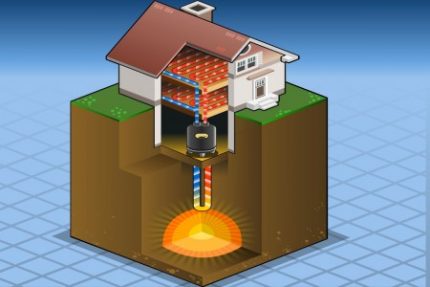
But we have all the necessary prerequisites for the use of low-temperature sources. The surrounding air masses, earth or water are suitable for this purpose.
A heat pump is used to extract the required energy. With its help, the procedure is carried out to convert the ambient temperature into thermal energy not only for heating, but also for hot water supply to a private household.
The operating principle of such heating
If you are familiar with how it works air conditioner or fridge, then the similarity of these processes with the operating principle of geothermal heating is obvious. The basis of the system is a heat pump, which is connected to two circuits - external and internal.
To organize a traditional heating system in any house, it is necessary to install pipes for transporting coolant and radiators, when heated, heat will flow into the premises. In our case, pipes and radiators are also needed. They form the internal contour of the system. Can be added to the diagram warm floor.
The external contour looks much larger than the internal one, although its dimensions can only be assessed during planning and installation. During operation, it is invisible because it is underground or underwater. Plain water or ethylene glycol-based antifreeze circulates inside this circuit, which is much preferable.
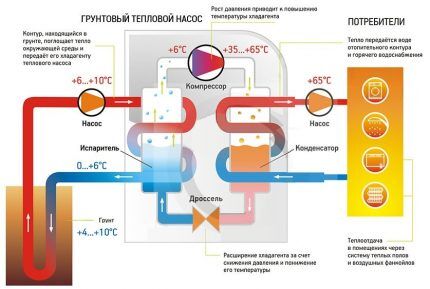
Thus, the key element that animates the entire system is the heat pump. If your home has an ordinary washing machine, then know: this pump will take up approximately the same area.
To operate, it needs electricity, but, consuming only 1 kW, it produces 4-5 kW of heat. And this is not a miracle, since the source of “additional” energy is known - this is the environment.
Two types of heat exchanger locations
There are two options for heating a private home using low-temperature energy from environmental elements. The basis of the system in all three cases is a geothermal pump.
The internal circuit remains unchanged for any heating method, and the main difference is the location of the external circuit.
Geothermal heating comes with a heat exchanger located:
- vertically — located in wells that penetrate or do not penetrate the aquifer;
- horizontally — heat exchangers of the systems are placed in a pit or open reservoir in the form of a kind of coil.
Each of the types of heating listed here is characterized by its own characteristics, disadvantages and advantages.
If you intend to create such a heating system with your own hands, you will be interested in learning more about each type.
Option 1. Vertical placement of the external collector
This type of heating is based on an interesting natural phenomenon: at a depth of 50-100 m or more from its surface, the earth has the same and constant temperature of 10-12°C all year round.
To be able to use this earth energy, it is necessary drill vertical wells. The technology is almost similar to the preparation of a water intake source.
In order to preserve the landscape as much as possible, several pipes can be drilled from the same starting point, but at different angles.
The external circuit of the system will be installed directly in these wells. This will allow you to effectively take away its heat from the earth. Of course, this method can hardly be called simple and low-budget.

It is relevant in the case when the territory adjacent to the house has already been developed, and disturbing its landscape is impractical. The depth of drilling a well can reach from 50 to 200 meters.
The specific parameters of the well depend on the geological situation at the site and the parameters of the future structure. The service life of this design is approximately 100 years.
To install a vertical version of the system with a heat exchanger that extracts the energy of underground water, you will need to drill two water-bearing wells.
From one of them, called the debit one, water is drawn using a pump, which, after heat transfer, is drained into the second, receiving outlet.
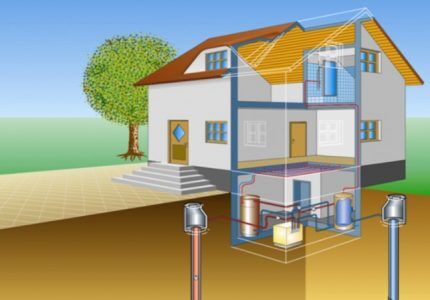
Option #2. Horizontal arrangement of the soil collector
To lay the external circuit for horizontal heating, you need to know to what depth the ground freezes in your area.
The pipes are laid below the freezing level in pre-prepared trenches, covering a fairly large space: to heat a house whose area is 200-250 square meters. m, you need to use approximately 600 sq. m heat exchanger. That is six hundred square meters.
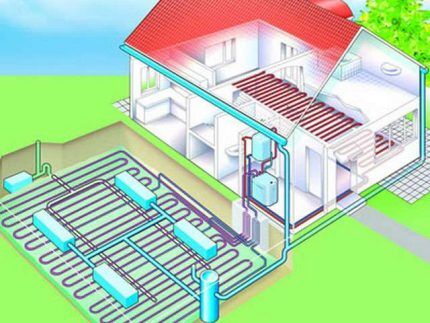
It is clear that under such conditions, the volume of excavation work will be significant. In addition, you need to take into account the location of trees and other vegetation on the site in your plan so as not to freeze them. For example, collector pipes should not be located closer than one and a half meters from trees.
This installation method is used, as a rule, in cases where the site is just being developed for construction. All calculations and plans for building a cottage, organizing its heating and planning the land plot are best carried out simultaneously.
Immersion of a horizontal heat exchanger in a reservoir
This method requires a special location of the household - at a distance of about 100 m from a reservoir of sufficient depth. In addition, the specified reservoir should not freeze to the very bottom, where the external contour of the system will be located. And for this, the area of the reservoir cannot be less than 200 square meters. m.

The obvious advantage of this method is the absence of mandatory labor-intensive excavation work, although you still have to tinker with the underwater location of the collector. And special permission to carry out such work will also be required.
However, a geothermal installation using water energy is still the most economical.
Do it yourself: what and how
If you are going to install geothermal heating yourself, then it is better to buy the external circuit ready-made. Of course, we are only considering ways to horizontally position the external heat exchanger: under the surface of the soil or under water.
It is much more difficult to install a vertical well collector yourself if you do not have the equipment and drilling skills.
A heat pump is not a very large piece of equipment. It will not take up much space in your home. After all, in size it is comparable, for example, to a conventional solid fuel boiler. Connecting the internal circuit of your home to it is not a difficult task.
In fact, everything is done exactly the same as when organizing and heating wiring using traditional heat sources. The main difficulty is the design of the external circuit.
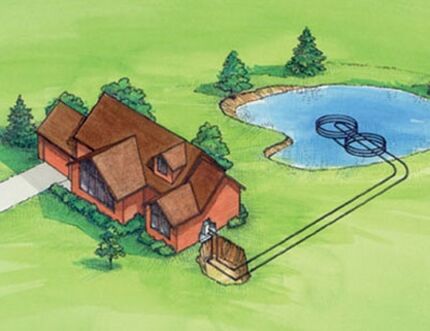
The best option would be to use a reservoir if one is found at a distance of no more than 100 m. It is necessary that its area exceed 200 sq. m. m, and the depth is 3 m (average freezing parameter). If this body of water does not belong to you, then obtaining permission to use it may become a problem.
If the reservoir is a pond that is on your property, then the matter becomes simpler. The water from the pond can be temporarily pumped out. Then work on its bottom can be done easily: you will need to lay the pipes in a spiral, securing them in this position.
Excavation work will only be needed to dig a trench, which will be needed to connect the external circuit to the heat pump.
After all work has been completed, the pond can be filled with water again. In the next hundred years, the external heat exchanger should work properly and not cause trouble to its owner.
If you have at your disposal a plot of land on which you just have to build housing and grow a garden, it makes sense to plan a horizontal ground-type heat exchanger.
To do this, you should make a preliminary calculation of the area of the future collector, based on the parameters already indicated above: 250-300 sq. m of collector per 100 sq. m of heated area of the house.

The trenches in which the circuit pipes are to be laid must be dug below the soil freezing level.
Better yet, simply remove the soil to the depth of its freezing, lay the pipes, and then return the soil to its place. The work is labor-intensive and complex, but with great desire and determination, you can complete it.
Costs and payback prospects
The costs of equipment and its installation during the construction of geothermal heating depend on the power of the unit and the manufacturer.
Everyone chooses a manufacturer based on their own considerations and information about the reputation and reliability of a particular brand. But the power depends on the area of the room to be served.

If we take power into account, the cost of heat pumps varies in the following ranges:
- at 4-5 kW – 3000-7000 conventional units;
- at 5-10 kW – 4000-8000 conventional units;
- at 10-15 kW – 5000-10000 conventional units.
If we add to this amount the costs that are needed to carry out installation work (20-40%), then we will get an amount that for many will seem absolutely unrealistic.
But all these costs will be recouped in a very reasonable time frame. In the future, you will only have to pay minor expenses for the electricity needed to operate the pump. And it's all!
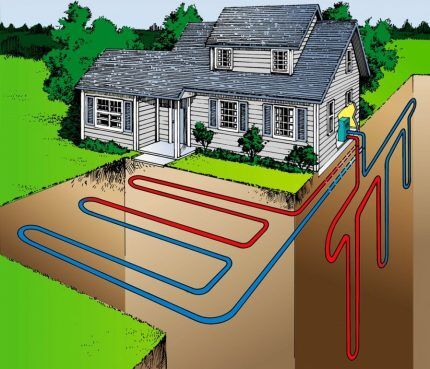
As practice shows, geothermal heating is especially beneficial for houses with a total heated area of 150 square meters. m. Within five to eight years, all costs for installing heating systems in these houses are fully recouped.
If geothermal heating is not particularly in demand among owners of private houses, then the effectiveness of solar systems has already been appreciated by residents of the southern regions. Technology solar heating structures is quite simple, and its efficiency and practicality are confirmed by many years of experience in use by Western countries and our compatriots.
For more information on alternative energy sources, see this article.
Conclusions and useful video on the topic
If it’s easier for you to perceive visual information, then this video will allow you to see with your own eyes exactly how a geothermal system functions, as well as learn more about who benefits from this type of heating and why.
We invite you to watch a short video in which the owner of a horizontal subsoil collector will talk about his impressions of its operation.Additionally, by watching this video, you will learn about the ongoing costs associated with operating a geothermal heating system.
Each owner of a private home chooses for himself whether to buy the services of resource supply organizations or rely only on himself. In doing so, he is guided by a whole list of considerations.
The goal we have set for ourselves is not to push you to a ready-made conclusion, but to share information about options for solving the problem facing you.
Do you have anything to add or have questions about geothermal heating of a private home? You can leave comments on the publication. The contact form is located in the lower block.




Geothermal heat sources are already being widely used in Europe to reduce the use of traditional fuels and thereby preserve the environment. We often read that states there provide all kinds of support for such projects, but in Russia so far we can only dream about it. Only enthusiasts deal with this issue.
As long as the price of geothermal heating is so high, it will not develop.
I am constantly interested in this topic. We would have such a system in every private house if the equipment and work for its construction were not so expensive. The costs will pay off very slowly, over 20-30 years; this is more of an investment in the future rather than a quick effect. Therefore, many states wisely financially support such events among the population. I am now interested in the cost of the unit and its power consumption.
Yeah! Do you think the payback period for main gas is less than 20-30 years? I will greatly disappoint you! Plus, there is an annual service agreement, which simply doesn’t exist, prices increase every year, etc.! Just think about it.
A person is interested in geothermal heating, and you are talking about gas. Trunk gas will not have a payback, since it is a priori not a free alternative. You confuse people with such statements and questions.
Now regarding geothermal heating equipment, its maintenance and warranty. Installation companies provide a warranty of 15-20 years.
At the moment, we can say that to heat a house of 100 m2 and provide it with hot water, you will need to pay about 6.5-7 thousand euros. Not such a big price to pay for your own practically free heating and hot water. This allows for a payback period of within five years. I will also attach a visual diagram of the operating principle of geothermal heating at home.